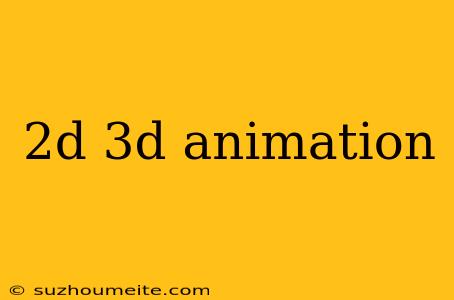2D 3D Animation: The Art of Bringing Imaginations to Life
Introduction
Animation is the process of creating the illusion of motion and life in characters, objects, and other graphical elements. It has been a cornerstone of entertainment, education, and advertising for decades. With the advent of technology, animation has evolved into two distinct forms: 2D and 3D animation. In this article, we will delve into the world of 2D and 3D animation, exploring their differences, similarities, and applications.
What is 2D Animation?
2D animation, also known as traditional animation, is a technique that involves creating the illusion of movement by manipulating flat, two-dimensional images. These images are drawn or painted on paper or created using computer software. The animator creates a series of poses or keyframes, and the software fills in the missing frames to create the illusion of movement.
Characteristics of 2D Animation
- Flat, two-dimensional characters and backgrounds
- Hand-drawn or computer-generated images
- Limited depth perception
- Often used for cartoons, anime, and educational videos
Famous Examples of 2D Animation
- Disney's Snow White and the Seven Dwarfs (1937)
- Looney Tunes
- Tom and Jerry
- Anime shows like Dragon Ball Z and Naruto
What is 3D Animation?
3D animation, also known as computer-generated imagery (CGI), is a technique that involves creating three-dimensional models and environments using computer software. These models are then animated using keyframe animation, physics, or other simulation techniques.
Characteristics of 3D Animation
- Three-dimensional characters and environments
- Computer-generated models and simulations
- Realistic lighting, shading, and texture
- Often used for films, video games, and architectural visualizations
Famous Examples of 3D Animation
- Toy Story (1995)
- Shrek (2001)
- Avatar (2009)
- Video games like Fortnite and Minecraft
Differences between 2D and 3D Animation
Style and Aesthetics
- 2D animation has a more stylized, cartoonish look
- 3D animation aims for realism and photorealism
Technical Requirements
- 2D animation requires drawing or painting skills
- 3D animation requires proficiency in computer software and programming
Production Time and Cost
- 2D animation is generally faster and less expensive
- 3D animation is more time-consuming and costly
Applications of 2D and 3D Animation
Entertainment
- Cartoons, anime, films, and video games
Education
- Educational videos, simulations, and interactive modules
Advertising
- Commercials, product demos, and explainer videos
Architecture and Real Estate
- Architectural visualizations, property tours, and interior design
Conclusion
2D and 3D animation are two distinct forms of animation that have their own strengths and weaknesses. While 2D animation excels in style and aesthetics, 3D animation offers realism and photorealism. Both forms have their applications in entertainment, education, advertising, and architecture. As technology continues to evolve, we can expect to see new and innovative applications of 2D and 3D animation.
